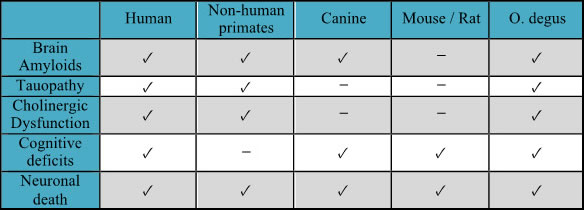Octodon Degus as a natural model of Alzheimer´s disease
O. degus display both intracellular and extracellular deposits of Aβ, intracellular accumulations of tau-protein and ubiquitin, a strong astrocytic response and acetylcholinesterase-rich pyramidal neurons, suggesting that degus could represent a new natural model for sporadic AD.
They show early cognitive and neural plasticity impairments observed before the appearance of fibrillar deposition.

Presence (✓) or absence (−) of AD pathological features is indicated (Braidy et al., 2015). or sporadic AD.
There are a variety of species that can serve as experimental models for AD research. In addition to numerous transgenic mouse lines, which have proven to be powerful tools to aid in understanding various aspects of the disease, there are other species that can serve as ‘natural’ wild-type models to shed light on different psychopathological mechanisms or even to try new therapeutic strategies. Among these natural models we emphasize the Octodon degus, they have APP is identical (97%) to the human counterpart, and in demonstrating age-dependent brain pathology and clinical correlates resembling ageing and AD.
MORE +